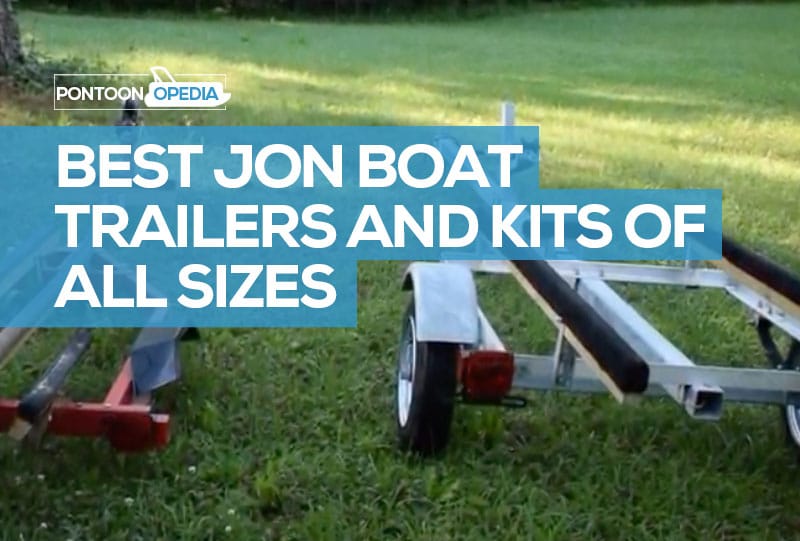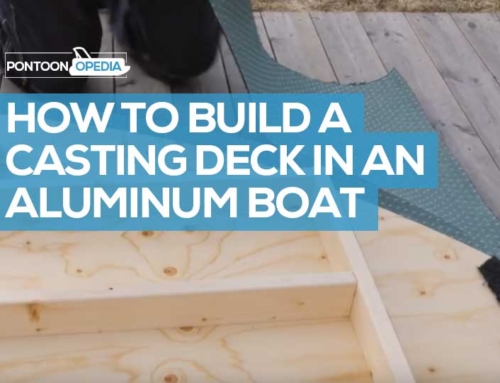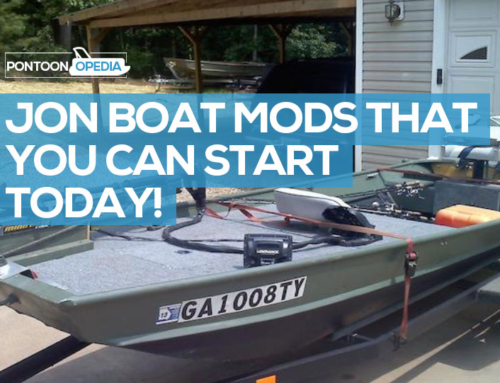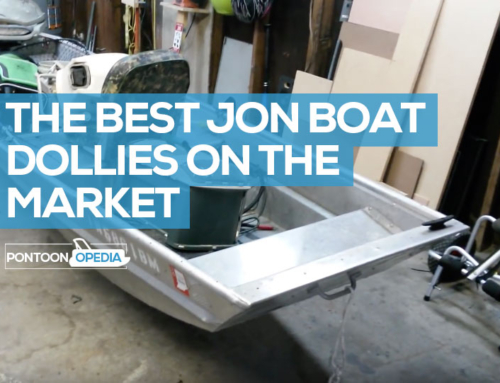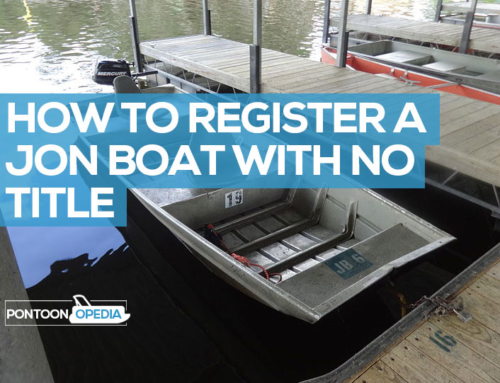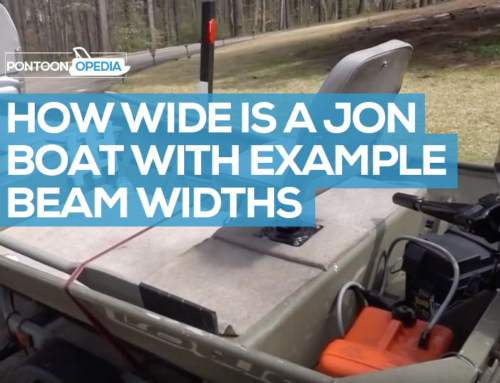In this guide to Jon boat trailers I am not going to cover how you can build you own. Instead you can see my recommendations which purely feature the best Jon boat trailer kit products which you can buy and quickly assemble from a manufacturer. Some are cheap, some not so much, but all of them come highly rated and reviewed.
Table of Contents
Best 10-foot Jon boat trailer kit
What trailer for a small Jon Boat is best, particularly if you are on a budget? I’d opt for the Ironton Jon boat trailer kit (view Amazon prices). It’s ideal for towing smaller boats.
It comes in a kit which almost anyone can put together using tools you’re already bound to have in your own garage. It easily holds a 10-foot Jon boat, is made from rugged steel, and can carry up to 610 pounds.
Here’s what you get:
- Rolls on 12-inch tires
- Roomy bed size is 77 ¼ inches long, 40 ¼ inches wide
- Overall size is 126 ¾ inches long, 52 ½ inches wide
- White powder-coat finish adds durability
- Includes lights, protective fenders and 1 7/8 inches coupler
In terms of delivery and assembly, it will be delivered at an address of your choosing by a large rig in 2 big boxes.
It comes with a manual and could take you anywhere between 2 and 4 hours to assemble from the kit. I would recommend you have someone to help you, as some parts are trickier with an extra pair of hands.
It’s a cheap Jon boat trailer. I’ve not found anything cheaper online.
Best 12-foot Jon boat trailer kit
If you need a 12-foot Jon boat trailer I would recommend the CE Smith Multi-Sport trailer (view Amazon prices). It’s very sturdy, and this manufacturer is one of top names in the United States. A great option but costs a little more money.
- Durable galvanized steel frame features an ample 800-pound load capacity
- Unloaded Weight 200 pounds
- Max Capacity 800 pounds
- Gross Vehicle Capacity: 1000 pounds
- Accommodates cargo up to about 12 foot long
- Includes 2-inch hitch coupler with safety chains, winch with strap and DOT approved lights
- Rolls on 8-inch wheels with fenders
As before, you will need to assemble the kit yourself, taking between 2 and 4 hours depending on your experience.
I need something larger…
If it’s larger trailers you want, then you probably won’t be able to buy them online, but instead will have to go into a dealer direct if you are looking for:
- Best 14-foot Jon boat trailer
- Best 15-foot Jon boat trailer
- Best 16-foot Jon boat trailer
There are number of manufacturers that I recommend, all of which offer great solutions. You can check out their websites and then go into a local marine dealer to see if they have any in stock.
Road King Trailers
This manufacturer builds a huge range of quality trailers for Jon boats, pontoon boats, skiffs, and more. They have been in business for years and have built up an excellent reputation in the industry.
They currently have two types of Jon boat trailers for sale; the RKG-14 and RKG-16W models.
Both come with flat-frames, which is what you want for a flat-bottomed Jon boat, have strongly welded frames, with either rollers or pads.
McClain Trailers
McClain are a leader when it comes to single-axel lightweight trailers, and manufacturer models ideal as 12-foot, 14-foot, 17-foot, and 18-foot.
If you need a 12-foot Jon boat trailer, or a 14-footer, then you can benefit from:
- Aluminum or galvanized aluminium frames
- Single axel models with 2 8-inch tires
- Winch stand with strap
- Galvanized fenders and safety chains
- Department of Transport approved lighting
Their larger models are ideal for use up to 16-foot Jon boat trailers and come with same features albeit with larger tires.
Backwater Trailers
If you want to spend more money, then opt for something custom built. You can something that is specifically for your Jon boat size, with any modifications you might have added.
You can benefit from:
- A hot dipped galvanized frame
- Galvanized torsion axles
- 13-inch galvanized wheels
- 10-foot bunks
- Carpeted guide on runners
- A diamond plate floor and smooth sides can be added to any custom Backwater trailer.
CE Smith Trailers
And lastly, if you don’t want to shop for a Jon boat trailer kit on Amazon, with my recommendations further up the page, then check out the CE Smith trailer range at your local dealer.
They manufacture multi-purpose trailers that are perfect for small Jon boats, coming in a kit that you should be able to quickly put together yourself.
You will also need a trailer hitch
That should give you enough options to be getting on with, but there is one more essential piece of equipment you will need for trailering; a trailer hitch.
If you don’t have one already installed on your vehicle, then you could be looking at extra few hundred dollars in getting something decent.
Need Jon boat trailer accessories or parts?
Whilst the trailers recommended and reviewed above are the best in the market, there will be additional things you can add in the form of accessories. You might even want to buy some spare parts.
I’ve put together another post which lists the best Jon boat trailer accessories and parts so you can take things to the next level or make any little fixes after wear and tear.
FAQs on Jon boat trailers
Hopefully the above guide has given a great insight into the best products, what you need to buy, and what you should get for your particular flat-bottomed Jon boat.
However, you still might have some questions relating to using it safely. You can find answers to the most commonly asked questions below, with my answers.
After the FAQs there are some tips to consider before you buy so you know exactly what to look for in a trailer.
1. Why do you need a trailer anyway?
Jon boats are light, with an aluminum 8-footer weighing in at around 100 pounds. You might get that into your truck’s bed.
But when it comes to the larger models, at 15-footer could weigh around 300 pounds. Based on that, any Jon boat of 10 feet and up tends to need a trailer.
2. How much does a Jon boat and trailer weigh?
Smaller Jon boat trailers tend to average between 200 and 300 pounds in weight, with larger models weighing it at around 600 pounds.
An average sized Jon boat from 10 to 14-foot weighs between 130 to 275 pounds.
There’s no exact answer to this question, it’s all down to the size of boat and trailer you have in combination.
3. How wide is a Jon boat trailer?
Just like your actual boat does, your trailer widths can vary too. Most of the time, the width won’t exceed 60 inches due to the small size of your chosen vessel.
Here are some sample widths based on the recommended trailers I’ve reviewed today.
- Road King RKG-14: 43 inches wide (about standard and average)
- Road King RKG-16W: 63 inches wide (if you want something larger!)
4. How much do Jon boat trailers cost?
You can pick up a cheap kit on Amazon for between $500 and $800. That’s probably where you are going to get the cheaper prices.
With some of the larger ones I have recommended, prices will invariably go up.
Some of the custom jobs could be in excess of $3,000 dollars – it pays to shop around!
5. How to know if a Jon boat trailer is highway rated?
Any trailer that you buy from a manufacturer should be fine to use on a highway. They wouldn’t sell it otherwise, unless it’s clearly stated that it is not for use on public road. Before you purchase anything, do the relevant checks.
When you buy a new or used trailer, it should have a capacity plate on it. This will show you what the weight capacity is. This is the most important factor for towing on highways and public roads.
A trailer capacity plate will have the following information on it:
- Max capacity
- Gross vehicle weight rating (GVWR)
- Gross axle weight rating (GAWR) for a given tire size and inflation pressure
To calculate how much you can tow, you need to do the following equation:
Max capacity is GAWR x number of axles = GVWR
You then take the weight of you trailer and subtract that from your GVWR calculated above.
In a real-world example, take a look at the capacity plate shown below.
As you can see, the GAWR is 2,550 and it has two axles. Therefore, the GVWR will be 5,100 pounds.
With the maximum weight capacity being rated as 4,000 pounds, that tells you the trailer will weigh 1,100 – so you cannot load it up with your boat, fuel, outboard, and accessories and exceed a safe towing weight of 4,000 pounds.
Keeping under that weight should keep you legal on the highways. If you are unsure, take vehicle, trailer, and boat to a public weighing scale just to make a peace of mind check.
Other aspects you should also consider for being legal on the highways and state roads are concerning your lights and license plate. It can differ from state to state, but generally speaking you need to:
- Have license plate lights that work
- Have reflectors on each side of your trailer
- Have turning signals on the trailer if it’s wider than 6.5 feet
Important note: This does not constitute legal advice at all, it’s simply information that I have researched online, so please do your own checks on the law in your state.
6. How to unload a Jon boat from a trailer?
Some hints and tips are best shown visually, and the unloading and launching your boat process is one such thing.
Below you can see a stepped video guide which shows the unloading and launch procedure in under 90 seconds.
7. How to load Jon boat on a trailer by yourself?
Just like the last question, this is better shown in a video tutorial.
The video tutorial below last 6 minutes, and make sure to watch it all as there are some great hints and tips in there on how to load your boat on the trailer alone and by yourself.
8. How fast can you go with a Jon boat trailer?
Every state in the US has its own law around trailer towing speeds. Previously on Pontoonopedia I’ve published a guide to trailer towing speed limits which you can read here.
This research was done some time ago, so please make sure you check to see if your local state has updated their laws since publishing, but this is what I found at the time:
- Alabama: 55 mph
- Alaska: 55 mph
- Arizona: 65 mph
- Arkansas: 65 mph
- California: 55 mph
- Colorado: 65 mph
- Connecticut: 55 mph
- Delaware: 55 mph
- District of Columbia: 55 mph
- Florida: 65 mph
- Georgia: 65 mph
- Hawaii: 55 mph
- Idaho: 65 mph
- Illinois: 55 mph
- Indiana: 65 mph
- Iowa: 65 mph
- Kansas: 65 mph
- Kentucky: 65 mph
- Louisiana: 65 mph
- Maine: 65 mph
- Maryland: 55 mph
- Massachusetts: 55 mph
- Michigan: 65 mph
- Minnesota: 65 mph
- Mississippi: 65 mph
- Missouri: 65 mph
- Montana: 65 mph
- Nebraska: 65 mph
- Nevada: 65 mph
- New Hampshire: 65 mph
- New Jersey: 55 mph
- New Mexico: 65 mph
- New York: 55 mph
- North Carolina: 65 mph
- North Dakota: 65 mph
- Ohio: 65 mph
- Oklahoma: 65 mph
- Oregon: 65 mph
- Pennsylvania: 55 mph
- Rhode Island: 55 mph
- South Carolina: 65 mph
- South Dakota: 65 mph
- Tennessee: 65 mph
- Texas: 60 mph during the day; 55 mph at night
- Utah: 65 mph
- Vermont: 65 mph
- Virginia: 55 mph
- Washington: 60 mph
- West Virginia: 65 mph
- Wisconsin: 65 mph
- Wyoming: 60 mph
It goes without saying that just because the speed limit is set, it doesn’t mean you have to hit it. The most important factor is to drive safely, and that means going slower in most cases, unless absolutely necessary.
Jon boats are very lightweight, as are the trailers so to hit top speeds could actually be very dangerous. Keep your speed down, as single axle trailers don’t track to the road as well as double axles do.
9. Will I need trailer brakes?
The majority of states require brakes on larger and heavier trailers. In most cases it only applies to trailers that are heavier than 3,000 pounds, so it’s unlikely to apply when towing a Jon boat.
What you will need though is a trailer chain.
It’s unthinkable not to have one, as if that trailer comes loose when you are driving, the results could be catastrophic.
10. Will I need a wide load trailer permit?
Again, it’s very unlikely as local laws only request you have one if your trailer width is more than 8 foot 6 inches wide.
Most Jon boat trailers don’t get any wider than 60 inches.
11. How to transport a Jon boat without a trailer?
What if you decide not to buy a trailer? Can you still transport your Jon boat without one?
It is possible but comes down to how long and wide your Jon boat is and what type of vehicle you have. I will often see people pulling up near our local lake, with their Jon boat carried in the back of their truck’s bed.
A local guy near me does exactly this, sliding his into the back of his truck and then ties it down. He also has a red flag attached to the part of the boat which slightly hangs out the back of his truck.
It doesn’t look that safe (or legal), but he’s been doing it for years with no problems. I don’t advise it though for obvious reasons!
What he should really get is a truck bed extender. They can extend how far out the back you can extend your bed and is adjustable.
Here’s a truck bed extender I like on Amazon.
Jon boats are very light compared to other vessels, and the smaller ones can be easily carried on top of your vehicle. But let’s say it’s 12-footer; even without all the gear onboard it could still weight in excess of 600 pounds – that’s not going to be easy to load up into the top of your vehicle.
What you can also buy are recreational truck racks. They work really well and are built for purpose.
There are plenty of different ones on the market, and I don’t have any preferred brands so go take a look at the options available on Amazon.
Bear in mind though, roof hauling isn’t easy. You have to get the boat up onto the roof, and it carries more of a risk in damaging your vehicle.
12. How to secure your Jon boat and trailer from being stolen?
Nothing will hurt you more than having your pride and joy stolen by some scumbag thieves. Believe it or not, boats and trailers are stolen to order almost every day.
If you leave your Jon boat and trailer parked up somewhere, even in your own garage, it’s still at risk of being stolen.
I’ve put together a guide elsewhere on Pontoonopedia which goes into a lot of detail on how you can stop your boat and trailer from being stolen which includes advice on how to park, GPS trackers, hitch locks, wheel clamps, cord alarms, and much more.
Read that guide to stopping thieves, and you will secure your prized assets from being taken.
Tips on buying a Jon boat trailer for sale
If you’re a first-time buyer and new to these kinds of boats, then here are some additional tips you might want to consider being getting your credit card out.
Shopping for a boat trailer can be tough, as there are so many different aspects you should consider. Below is a list of all things you might come across when shopping, and what they mean.
Trailer size
As previously discussed, the GVWR (gross vehicle weight rating) is how much the trailer is allowed to carry, including the boat, engine, fuel and equipment.
I’d always recommend that you keep between 15% to 20% lower when towing, just to be completely safe.
Single axle trailers
You will save money if you opt for a single axle trailer, you probably won’t need to maintain is much, and they are easier to move about by hand if you need to get into a tight space or drive.
But, in most cases they won’t be able to carry as much weight but should be fine for most size and weight of Jon boat. I’d only go for something with two or more axels if you own a larger boat as well or are going to moving something larger in the future.
Multiple axle trailers
It’s unlikely you would ever tow a Jon boat on a multiple axle trailer, unless you already have one of course.
There are much heavier and not easy to push around manually but will stick to the road better when you’re driving and won’t flip about if a tire goes.
Lighting
If you can, get a trailer with LED lights. They will last a lot longer than standard lights and have the benefit of being waterproof and much brighter.
You might not find many single axel trailers with LEDs, so at the very least see if you can find one with light fittings that are recessed and covered so they don’t get water damage.
And lastly, the lights need to be Department of Transport approved so other road users can see you, particularly when you need to slow down and brake.
Tires
For the best road grip, I advise radial tires as opposed to bias-ply ones.
Radial tires don’t transmit sidewall flex onto the tread and leave a larger footprint. That gives you more grip when trailering and towing.
Frame construction
If buying new or used, check the welding. It needs to be smooth and well-constructed to withstand all the bumps and jumps you’re going to put it through when pulling down to the water’s edge.
Galvanized steel trailers will be heavier and won’t rust. But if you’re boating in freshwater or on a budget then painted steel should be fine.
Aluminum tends to be the preferred option for Jon boat trailers, as it’s lightweight, won’t corrode, and will be easier to move around manually.
Bunks
Jon boats have flat bottoms, so flat bunks are preferred here. Otherwise you won’t have the stability you need when towing.
I also prefer carpeted bunks as they will protect the bottom of your Jon from getting scratched up. But carpeted bunks will absorb water which could corrode your boat bottom if you leave it on there without proper care and attention.
The last word…
I hope that you have found this guide helpful. I recently published a guide to Jon boat accessories that are essential, I think you might find that interesting too!
This website originally started out as my little place on the Internet where I would talk about my love of pontoon boats, but has since expanded to include all the different types of boat that I love to use.

